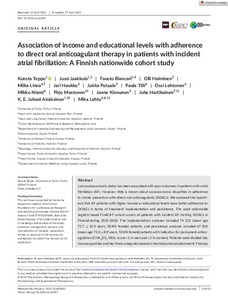Association of income and educational levels with adherence to direct oral anticoagulant therapy in patients with incident atrial fibrillation: A Finnish nationwide cohort study
Teppo Konsta; Jaakkola Jussi; Biancari Fausto; Halminen Olli; Linna Miika; Haukka Jari; Putaala Jukka; Tiili Paula; Lehtonen Ossi; Niemi Mikko; Mustonen Pirjo; Kinnunen Janne; Hartikainen Juha; Airaksinen K. E. Juhani; Lehto Mika
Association of income and educational levels with adherence to direct oral anticoagulant therapy in patients with incident atrial fibrillation: A Finnish nationwide cohort study
Teppo Konsta
Jaakkola Jussi
Biancari Fausto
Halminen Olli
Linna Miika
Haukka Jari
Putaala Jukka
Tiili Paula
Lehtonen Ossi
Niemi Mikko
Mustonen Pirjo
Kinnunen Janne
Hartikainen Juha
Airaksinen K. E. Juhani
Lehto Mika
JOHN WILEY & SONS LTD
Julkaisun pysyvä osoite on:
https://urn.fi/URN:NBN:fi-fe2022081153928
https://urn.fi/URN:NBN:fi-fe2022081153928
Tiivistelmä
Low socioeconomic status has been associated with poor outcomes in patients with atrial fibrillation (AF). However, little is known about socioeconomic disparities in adherence to stroke prevention with direct oral anticoagulants (DOACs). We assessed the hypothesis that AF patients with higher income or educational levels have better adherence to DOACs in terms of treatment implementation and persistence. The used nationwide registry-based FinACAF cohort covers all patients with incident AF starting DOACs in Finland during 2011-2018. The implementation analyses included 74 222 (mean age 72.7 +/- 10.5 years, 50.8% female) patients, and persistence analyses included 67 503 (mean age 75.3 +/- 8.9 years, 53.6% female) patients with indication for permanent anticoagulation (CHA(2)DS(2)-VASc score >1 in men and >2 in women). Patients were divided into income quartiles and into three categories based on their educational attainment. Therapy implementation was measured using the medication possession ratio (MPR), and patients with MPR >= 0.90 were defined adherent. Persistence was measured as the incidence of therapy discontinuation, defined as the first 135-day period without DOAC purchases after drug initiation. Patients with higher income or education were consistently more likely adherent to DOACs in the implementation phase (comparing the highest income or educational category to the lowest adjusted odds ratios 1.18 (1.12-1.25) and 1.21(1.15-1.27), respectively). No association with income or educational levels was observed on the incidence of therapy discontinuation. In conclusion, we observed that income and educational levels both have independent positive association on the implementation of DOAC therapy but no association on therapy persistence in patients with AF.
Kokoelmat
- Rinnakkaistallenteet [27094]
